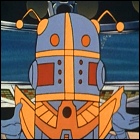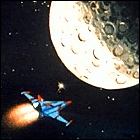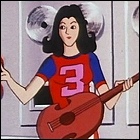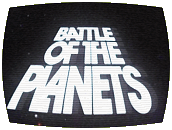This series aired in daily strip syndication across the United States, Canada and the UK between 1979 and 1981. It was common for stations to “bicycle” tapes – air them and then ship them to the next station in the chain – for daily syndicated shows at this time, so there is no set official airdate for these episodes. See below the episode list for more.
Originated in 1972 in Japan as Fuji TV’s hit anime series Kagaku Ninjatai Gatchaman (Science Ninja Team Gatchaman), Battle Of The Planets was the result of syndication mogul Sandy Frank’s desire to capitalize on the Star Wars craze sweeping America in late 1977. Frank settled on Gatchaman as being the easiest to adapt (not surprisingly, since Gatchaman itself had been inspired partly by American superhero comics), and set about having his writers and a new voice cast translate and redub the series for American audiences.
But it wasn’t that easy.
 The high violence quotient in Gatchaman meant that the series would be impossible to translate as-is for afternoon children’s TV timeslots. Each Gacthaman episode requried trims – some major, some rather drastic, meaning that a varying amount of time would have to be filled from episode to episode. This led to the creation of the robot 7-Zark-7 and his robot dog, 1-Rover-1. New animation featuring these characters was generated, and new dialogue written, often to reassure young viewers that each adventure’s high body count was acceptable because the alien soldiers were actually androids and robots! At first, the new characters never met the original Gatchaman characters, but gradually new animation of the Gatchaman characters was generated to include them on 7-Zark-7’s viewscreens and, later, meeting the robot in person (though the difference in American and Japanese artwork styles made the difference between the original Gatchaman footage and the new animation featuring those characters acutely noticeable).
The high violence quotient in Gatchaman meant that the series would be impossible to translate as-is for afternoon children’s TV timeslots. Each Gacthaman episode requried trims – some major, some rather drastic, meaning that a varying amount of time would have to be filled from episode to episode. This led to the creation of the robot 7-Zark-7 and his robot dog, 1-Rover-1. New animation featuring these characters was generated, and new dialogue written, often to reassure young viewers that each adventure’s high body count was acceptable because the alien soldiers were actually androids and robots! At first, the new characters never met the original Gatchaman characters, but gradually new animation of the Gatchaman characters was generated to include them on 7-Zark-7’s viewscreens and, later, meeting the robot in person (though the difference in American and Japanese artwork styles made the difference between the original Gatchaman footage and the new animation featuring those characters acutely noticeable).
 Other, more superficial changes were made: where the original Gatchaman took place entirely on Earth, with an alien entity influencing a rogue megalomaniac’s constant grabs for world domination, Battle Of The Planets also filled time gaps left by the deleted violent scenes with new animation of the Phoenix journeying through space to other worlds where G-Force’s help was needed. (Naturally, these other worlds wound up looking a lot like Earth on the ground level, but Sandy Frank demanded a “space” element to further capitalize on the success of Star Wars.)
Other, more superficial changes were made: where the original Gatchaman took place entirely on Earth, with an alien entity influencing a rogue megalomaniac’s constant grabs for world domination, Battle Of The Planets also filled time gaps left by the deleted violent scenes with new animation of the Phoenix journeying through space to other worlds where G-Force’s help was needed. (Naturally, these other worlds wound up looking a lot like Earth on the ground level, but Sandy Frank demanded a “space” element to further capitalize on the success of Star Wars.)
Other aspects of the now-international production blended somewhat more gracefully: American composer Hoyt Curtin was granted special dispensation from his contract work for Hanna-Barbera to create new music for Battle Of The Planets, including a new theme song. His music fitted almost seamlessly along the early ’70s stylings of  Gatchaman composer Bob Sakuma, whose music was left intact whenever possible (when it wasn’t butchered by the edits). While an album of Sakuma’s music was available in Japan from the late ’70s onward, fans didn’t stop lobbying for an album featuring both composers until an official Battle Of The Planets soundtrack was issued in 2001, arriving alongside the first DVD releases.
Gatchaman composer Bob Sakuma, whose music was left intact whenever possible (when it wasn’t butchered by the edits). While an album of Sakuma’s music was available in Japan from the late ’70s onward, fans didn’t stop lobbying for an album featuring both composers until an official Battle Of The Planets soundtrack was issued in 2001, arriving alongside the first DVD releases.
Entire plot threads from Gatchaman were omitted from Battle Of The Planets, namely Joe’s slowly worsening physical and mental health and the gender-bending nature of Berg Katse (renamed Zoltar in Battle Of The Planets); indeed, the last 1/5 of Gatchaman was never even seriously considered for translation to Battle Of The Planets episodes because those plot threads were so prevalent, and the episodes were simply too violent. Scripts were written, and pre-production undertaken, to create completely new episodes featuring the Gatchaman characters without using any of the original Japanese animation at all.
In the end, however, none of those stories were ever animated: Battle Of The Planets’ competition in the television sci-fi arena had become too formidable, with live-action shows such as Jason Of Star Command, Battlestar Galactica and Buck Rogers In The 25th Century each trying to rival the spectacle of Star Wars. And with the first Star Wars sequel, The Empire Strikes Back, looming in 1980, Sandy Frank decided to put an end to Battle Of The Planets before the show outstayed its welcome (and probably to avoid incurring the cost of having to generate new animation in-house). Battle Of The Planets remained a popular fixture of syndicated afternoon TV through the early ’80s.
In the late 1980s, another attempt to translate Gatchaman to English was undertaken at Turner Broadcasting, resulting in the series G-Force: Guardians Of Space. Fans have heavily criticized the latter-days series despite the fact that it more closely resembles its source material by reinstating some of the previously cut fight scenes and omitting the Sandy Frank-created robot sidekicks; the voice acting is often panned, along with the across-the-board replacement of much of the music – either Sakuma’s or Curtin’s – with endless drum machine loops. However cheesy Battle Of The Planets may have been with the deletion of countless scenes and the addition of cute robots, English-speaking fans seemed to prefer what they perceived to be the “original” show.
A handful of U.S. DVD releases and a complete-series DVD box set in England brought Battle Of The Planets back to its fans in the early 2000s. But with the 2007 lapse of Sandy Frank’s rights to further exploit the Gatchaman footage, future availability of this variation on Gatchaman is uncertain.
- Attack Of The Space Terrapin
- Rescue Of The Astronauts
- The Space Mummy
- The Space Serpent
- Ghost Ship Of Planet Mir
- Big Robot Gold Grab
- Ace From Outer Space
- Fearful Sea Anemone
- Jupiter Moon Menace
- A Swarm Of Robot Ants
- Space Rocket Escort
- Beast With A Sweet Tooth
- Perilous Pleasure Cruise
- The Thing With 1000 Eyes
- Microfilm Mystery
- The Alien Beetles
- A Whale Joins G-Force
- Mad New Ruler Of Spectra
- The Sea Dragon
- Magnetic Attraction
- The Musical Mummy
- The Fiery Lava Giant
- The Bat Ray Bombers
- Race Against Disaster
- The Ghostly Grasshopper
- The Galaxy Girls
- Curse Of The Cuttlefish Part I
- Curse Of The Cuttlefish Part II
- Demons Of The Desert
- Siege Of The Squids
- Orion, Wonder Dog Of Space
- The Fierce Flowers Part I
- The Fierce Flowers Part II
- The Space Rock Concert
- Prisoners In Space
- Victims Of The Hawk
- Raid On Riga
- Seals Of Sytron
- Giant Gila Monster
- The Capture Of The Galaxy Code
- Raid On A Nearby Planet
- Keyop Does It All
- Peaks Of Planet Odin
- The Sky Is Falling! Part I
- The Sky Is Falling! Part II
- Raid Of The Red Scorpion
- Mammoth Shark Menace
- Fastest Gun In The Galaxy
- Giant From Planet Zyr
- Secret Island
- Giant Space Bat
- Attack Of The Alien Wasp
- Decoys Of Doom
- Zoltar Strikes Out
- The Great Brain Robbery
- Silent City
- Peril In The Pyramids
- Raid Of The Space Octopus
- Rage Of The Robotoids
- The Alien Bigfoot
- Invasion Of The Locusts
- Space Safari
- Museum Of Mystery
- Peril Of The Preying Mantis
- Awesome Ray Force
- The Duplicate King
- Defector To Spectra
- Panic Of The Peacock
- Mission To Inner Space
- Spectra Space Spider
- Super Space Spies
- Cupid Does It To Keyop
- Tentacles From Space
- Island Of Fear
- The Awesome Armadillo
- Invasion Of Space Center Part I
- Invasion Of Space Center Part II
- Save The Space Colony
- Charioteers Of Changu
- Vacation On Venus
- Rockets Out Of Control
- GForce Defector
- Strike At Spectra
- GForce In The Future
- The Conway Tape Tap
More notes on dating these episodes: numerous sources seem to agree on a rough date of early September 1978, so for the purposes of this guide an arbitrary date of Tuesday, September 5th, 1978 has been assigned as the airdate of the first episode (Monday the 4th would’ve been Labor Day, a national holiday and also the airdate of the then-ubiquitous MDA Muscular Dystrophy Telethon – a date most stations, if they weren’t airing the telethon already – would’ve avoided competing with as the telethon was a ratings giant at the time). The dates assigned to this and subsequent episodes may not necessarily be the date that the episodes in question aired in your local market, but should be a rough approximation of the show’s air schedule. Episodes aired Monday through Friday, and (again somewhat arbitrarily) this guide will assume that, after its premiere in September 1978, the show went into reruns when not in a major “sweeps month” for Nielsen television ratings in the U.S.


